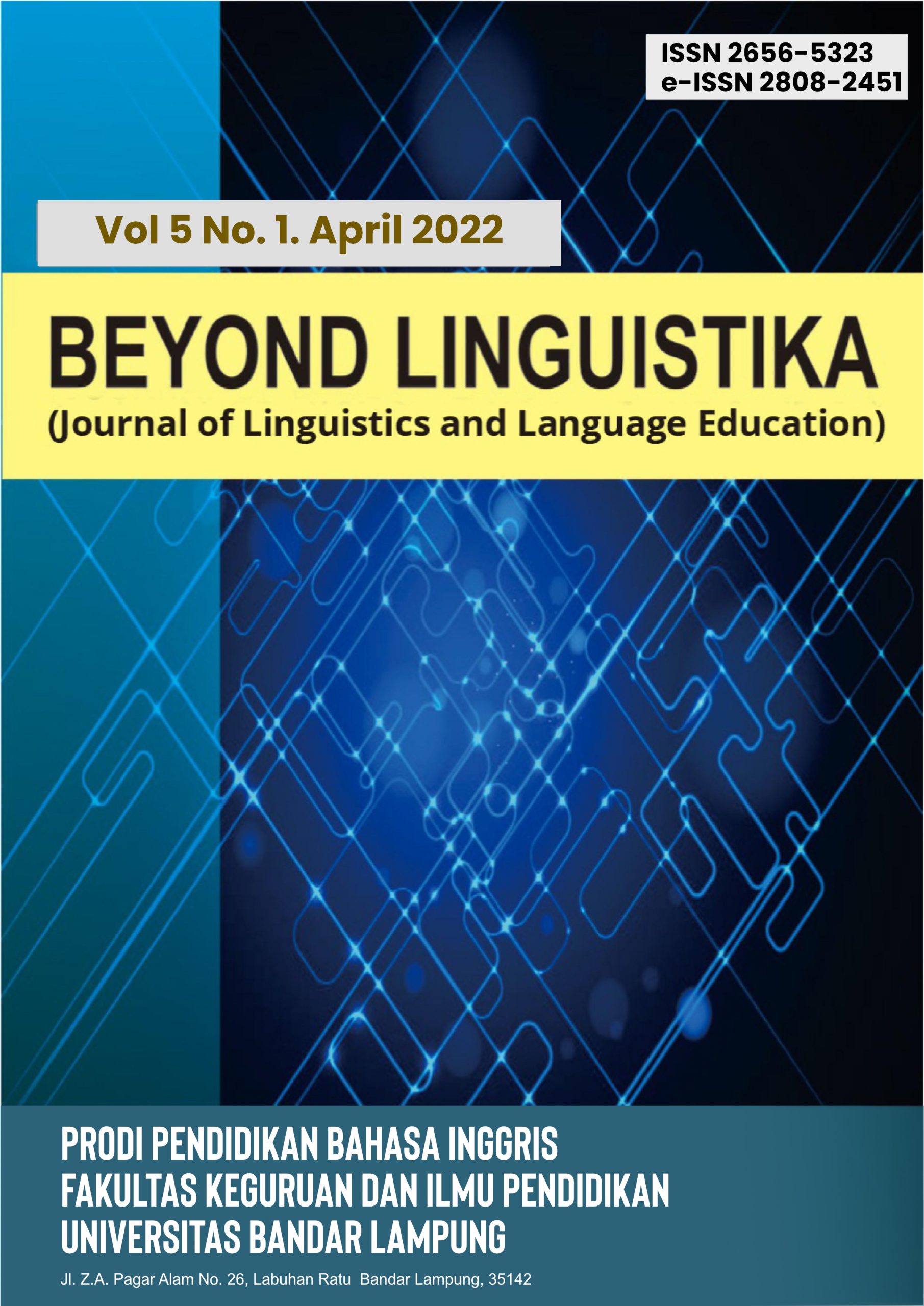THE PERCEPTION ON USING DARK JOKES IN STUDENT DAILY CONVERSATION
Abstract
In this modern era, people can easily get information from anywhere and anytime. People can also express their opinions and thoughts about a topic, for example about jokes. There are so many genres or types of jokes, one of them is dark jokes. Dark joke is a form of humor involving a twist or joke making the joke seen as offensive, harsh, horrid. Because of that, some people argue that dark jokes should not be used in daily life. The aim of this research is to analyze the students’ perception about using dark jokes in daily conversation English Department of Universitas Bandar Lampung and analyze some aspects of perception that affect students’ perception about using dark jokes in daily conversation. This research used case study method. The research was done at English Education Study Program Faculty of Teacher Training and Education Universitas Bandar Lampung in all semester. Data gathering was done by doing questionnaire and interview to nine students. The data was analyzed by combining the result from the questionnaire and interview. The results of this research elucidated that they have mix perception towards dark joke and using it in daily conversation. Some of them concur and some of them disagree that dark joke can be used in daily conversation.
Keywords
Full Text:
PDFReferences
Arikunto, S. 2010. Prosedur Penelitian Suatu Pendekatan Praktik. Jakarta: Rineka Cipta.
Brennan, S. (2013). Encyclopedia of the Mind: edited by Harold Pashler (Conversation and Dialogue). 202–205. https://books.google.co.uk/books?id=Ei51AwAAQBAJ&pg=PA205&lpg=PA205&dq=susan+brennan+conversation+and+dialogue+encyclopedia+of+mind&source=bl&ots=PMBd4kKSPH&sig=wQK_rAspoNP-O1Fwr7G7pkqKiFE&hl=en&sa=X&ved=0ahUKEwiGmpW22aTMAhVE8ywKHRpSBNsQ6AEIKDAC#v=onepage
Christopher, S. (2015). An introduction to black humour as a coping mechanism for student paramedics. Journal of Paramedic Practice, 7(12), 610–617. https://doi.org/10.12968/jpar.2015.7.12.610
Creswell, J. W. (2010). Mapping the Developing Landscape of Mixed Methods Research.
Creswell, J.W. (2012). Educational Research Planning, Conducting, and Evaluating Quantitative and Qualitative Research. Boston, USA:Pearson Education, Inc.
Démuth, A. (2012). Perception Theories. In Applications of Case Study Research (Issue 4). http://issafrica.org/crimehub/uploads/3f62b072bd80ab835470742e71a0fcb5.pdf%5Cnhttp://www.cdc.gov/ViolencePrevention/pdf/SchoolViolence_FactSheet-a.pdf%5Cnwww.sace.org.za
Dynel, M., & Poppi, F. I. M. (2018). In tragoedia risus: Analysis of dark humour in post-terrorist attack discourse. Discourse and Communication, 12(4), 382–400. https://doi.org/10.1177/1750481318757777
Hadiati, C., & Soedirman, U. J. (2018). Humor is Some Linguistic Perspectives. The Third Conference on Language, Linguistics, and Literature: Humor and Horror in Language, Literature, and Culture, May.
Hakulinen, Auli. (2000). Conversation types.
HİŞMANOĞLU, M. (2018). Turkish EFL Learners’ Perceptions on Teachers’ Using Humor in the EFL Classroom. International Journal of Languages’ Education, 1(Volume 6 Issue 2), 284–294. https://doi.org/10.18298/ijlet.2820
Machlev, M., & Karlin, N. J. (2017). The relationship between instructor use of different types of humor and student interest in course material. College Teaching, 65(4), 192–200. https://doi.org/10.1080/87567555.2017.1333080
McGrail, E., & Rieger, A. (2014). Humor in Literature About Children with Disability: What Are We Seeing in Literature? Educational Forum, 78(3), 291–304. https://doi.org/10.1080/00131725.2014.912368
Qiong, O. U. (2017). A Brief Introduction to Perception. Studies in Literature and Language, 15(4), 18–28. https://doi.org/10.3968/10055
Skalicky, S., Berger, C. M., Crossley, S. A., & Mcnamara, D. S. (2016). Linguistic Features of Humor in Academic Writing. Advances in Language and Literary Studies, 7(3). https://doi.org/10.7575/aiac.alls.v.7n.3p.248
Sugiyono. 2010. Metodologi Penelitian Administrasi. Jakarta: CV. Alfabeta
Vivona, B. D. (2014). “To laugh or not to laugh”: Understandings of the appropriateness of humour and joking in the workplace. European Journal of Humour Research, 2(1), 1–18. https://doi.org/10.7592/ejhr2014.2.1.vivona
Warren, C., Barsky, A., & Mcgraw, A. P. (2018). Humor, Comedy, and Consumer Behavior. Journal of Consumer Research, 0(May). https://doi.org/10.1093/jcr/ucy015
West, M. S., & Martin, M. M. (2019). Students’ perceptions of instructor appropriateness and humor homophily. Communication Education, 68(3), 328–349. https://doi.org/10.1080/03634523.2019.1608368
Sidabalok, D.M. and Fitriana, S. (2018). The Analysis of Students’ Critical Thinking in Online Discussion Forum by Using Schoology in Speaking B Class of First Semester Students of FKIP UBL.
Linguistika: Jurnal Pendidikan Bahasa Inggris. Bandar Lampung: Program Studi Pendidikan Bahasa Inggris Fakultas Keguruan dan Ilmu Pendidikan Universitas Bandar Lampung https://doi.org/10.30653/005.201921.39
Harpain, H., Sidabalok, D. M., Cahyani, M. A. S., & Yulfriwini, Y. (2019). Developing Instructional Design Model of Speaking Skill for First Year Undergraduate Students. Journal of Language Teaching and Research, 10(6), 1225. https://doi.org/10.17507/jltr.1006.10
DOI: http://dx.doi.org/10.36448/bl.v5i1.2517
Refbacks
- There are currently no refbacks.















